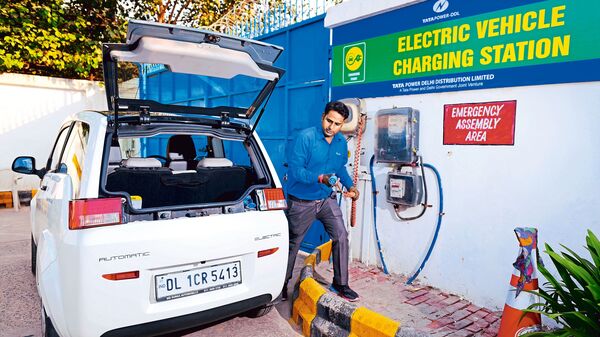Electric vehicle sales in India crossed one million (10 lakh) in FY23, with two-wheelers contributing the bulk of sales. The Society of Manufacturers of Electric Vehicles (SMEV) said the entire EV industry sold 11,52,021 units, or 58% more than the 7,26,861 units sold in FY22.
Two-wheelers contributed over 60% of sales with 7,26,976 high-speed electric two-wheelers sold. But production tapered off towards the end of the fiscal. The final sales figures were well short of the minimum target of 10 lakh EV two-wheelers in FY23 set by Niti Aayog. Two-wheeler sales also included 120,000 low-speed e-scooters, 2,85,443 e-rickshaws, and around 50,000 e-cycles, taking combined two-wheeler sales to 8,46,976 units in FY23, a big jump from 328,000 in FY22. Apart from this, 401,841 electric three-wheelers, 47,217 electric three-wheelers, and 1904 electric buses were sold in FY23.
A slew of government incentives seems to have worked to a certain extent. But the subsidy schemes under the Faster Adoption and Manufacturing of (Hybrid &) Electric Vehicles in India II (Fame-II ) norms may have run into trouble and there are chances the subsidy mechanism will be rebooted.
The SMEV claims that delays in Fame-II subsidy disbursals have led to slower manufacturing. Fame-II has a capital outlay of ₹10,000 crore to support the manufacture of 10 lakh electric two-wheelers, five lakh electric three-wheelers, 55,000 electric four-wheelers and 7,000 buses. This subsidy allows on-road prices to be cut by around 35%.
In addition, another ₹10,000 crore has been allotted under Fame-II for EV charging stations. In 2022, 2,877 stations were approved in 68 cities and another 1,576 along highways. Fame-II was redesigned in June 2021 based on the pandemic experience and industry feedback. By October 22, 64 EV manufacturers had registered to receive incentives.
To qualify for Fame-II subsidies, original equipment manufacturers must make, or source, at least 50% of components in India. The Automotive Research Association of India (ARAI) tests this localisation percentage before an EV is certified. Local component manufacturers became interested as Fame-II promised volumes and this kick-started localisation. The government is able to track via software the OEMs’ compliance data and traceability of components. This tech-enabled linkage is used to calculate the disbursal of incentives.
In December 2022, the government said it was investigating 12 manufacturers for possible misappropriation of funds given under Fame-II. Stakeholders said there have been delays in the release of over ₹1,200 crore of subsidies already committed and passed on to customers via price cuts..
Government sources said the delay is due to manufacturers not coming through on localisation commitments. Another ₹400 crore is stuck because of investigations into possible under-invoicing. This has hindered manufacturers who relied on those funds for working capital.
According to the SMEV, 16 companies with a combined market share of over 95% are waiting for these issues to be resolved, and for a possible reset of Fame subsidies. The industry is also seeking an extension of Fame-II eligibility criteria by two years and an extension of the subsidy scheme for another three years beyond the scheduled end on March 31, 2024.
While this creates supply-side challenges, the demand shows that users no longer have excessive safety-related concerns. The charging ecosystem has ramped up to the point where users no longer worry about running out of juice. Apart from personal vehicles, cab companies such as BluSmart, with its fleet of EVs, have started to gain acceptance.
While EVs look similar to their fossil-fuel-driven ancestors on the outside, they are very different in engineering terms, and that affects the component ancillary supply chain and the repair and maintenance ecosystem.
An EV has far fewer moving parts than an internal combustion engine (ICE) vehicle. This means that EVs also require less in the way of general repair and maintenance. The components themselves are quite different, too. Everything is designed around the battery, which contributes a large proportion of weight. Since power and torque are available near-instantaneously, EVs have a fast “pickup” – as acceleration is called in India. Moreover, EVs are much quieter – indeed so quiet that they often catch pedestrians unawares.
Incentives for battery design and production, and the battery and component supply chain, may be addressed in future through production-linked incentive (PLI) schemes rather than Fame. One PLI scheme has an outlay of ₹18,100 crore for advanced chemistry cell batteries. Many beneficiaries have been announced under this scheme, such as Reliance New Energy Solar, Ola Electric Mobility Private Limited, Hyundai Global Motors Company Limited, and Rajesh Exports Limited. To qualify for these incentives, manufacturers must achieve 60% localisation by year five.
Another 20 companies have been approved under a different PLI scheme with an outlay of ₹25,938 cr to make EV components. This suggests that Fame-II may end on schedule, with incentives shifting to PLI. That adds a layer of uncertainty.
Policymakers need to sort this out quickly if they are to achieve the target of making two- and three-wheelers sales 100% electric in the next five years.
Download The Mint News App to get Daily Market Updates.
More
Less
#Demand #drives #Indias #sales #policy #confusion
